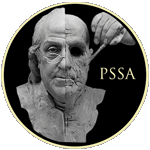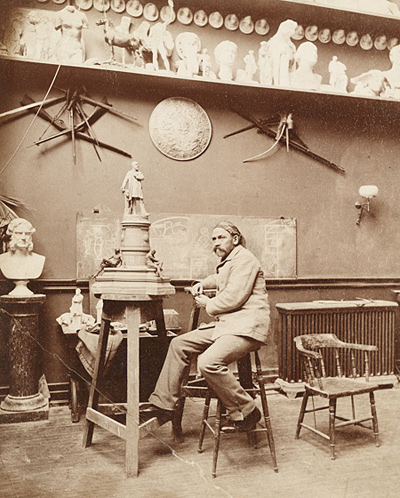Featured ArtistJohn Quincy Adams Ward, Dean of 19th Century American sculpture, 1830-1910
Written by: Ivan Schwartz, Founder, Director StudioEIS, www.studioeis.com
A couple of years ago, I was looking at the US Capital building and came upon a monument to one of America ’s lesser known Presidents, James Garfield. The figure of Garfield was conventional enough, and good enough, but the figures surrounding the base of the monument were very dynamic and recalled Michelangelo. A bit of an exaggeration, but there was a powerful dynamism and extraordinary drama in this group of old fashioned figures, and as it turned out, they were by the sculptor John Quincy Adams Ward.
My studio, located on the Brooklyn waterfront is very near to a monument dedicated to Henry Ward Beecher, completed four years after his death in 1891. Beecher, the abolitionist clergyman, whose association with the Plymouth Church of the Pilgrims, the abolitionist movement, and Abraham Lincoln caused him, to become The Most Famous Man in America, in the words of his biographer, Debby Appelgate.
The Beecher monument by John Quincy Adams Ward is an outstanding group of figures, celebrated by more than 15,000 people when it was unveiled on June 24 of 1891. Beecher was a hugely important American - his contribution to the abolitionist movement and the mock weddings he performed with escaped slaves on the Underground Railroad; wedding them symbolically to freedom, made him a great figure in American history. Ward’s sculpture of Beecher is the absolute synthesis of what I would call a great and gifted Storyteller/sculptor with a great story to tell.
Within hours after Beecher ’s death in 1887, Ward had taken a death mask, and four years after his death Brooklyn had a great sculpture of Beecher , and this sculpture remains one of the great American sculptures of this period. The only reason I qualify country of origin, is a point of information. Rodin and the great French school were operating simultaneously, and their interests and stylistic direction are quite different to that of John Quincy Adams Ward. Indeed their fame eclipsed that of the American school for artistic and historical reasons.
However, as I travel back and forth to Washington from New York , I’ve been struck by the number of times I’ve been able to recognize a Ward sculpture from the rest of the pack - after all, our cities and parks are filled with examples of pretty ordinary 19 th century sculpture. But with America’s pursuit of its “deep historical essence” through the 19 th century, as events, and gifted individuals recorded them - Ward consistently produced not only extremely fine utilitarian works, recording American history, but also great portrait sculpture equal to that of nearly anyone before or since… With our Revolution and Civil War as part of recent history, and an appetite for going to war, America has had much to celebrate and depict through its heroes – as it happened an elite group of painters and sculptors were on hand to record those events.
A number of great 18 th century men, paparazzi of their day, followed the American Presidency – Gilbert Stuart, John Trumbull and Charles Wilson Peale, amongst the painters, and perhaps greatest of all, the French sculptor, Houdon. They traveled the country, and in Houdon’s case, the world, in pursuit of access to the founding generation of American leaders, and Ward, by the mid to late 19 th century continued a tradition of working on the coattails of history.
But Ward wasn’t a mere slavish literal storyteller, and this is why you can find his works in many places. He was profoundly gifted, and I find whenever I stand in front of one of his portraits, the essence of the person he has sculpted is conveyed with potent self assurance. By the mid 20 th century abstraction eventually came to hold sway in the art world, but anyone with an interest in history and the great figurative tradition in sculpture should not miss the quiet power of an absolute master of the form – John Quincy Adams Ward. |






